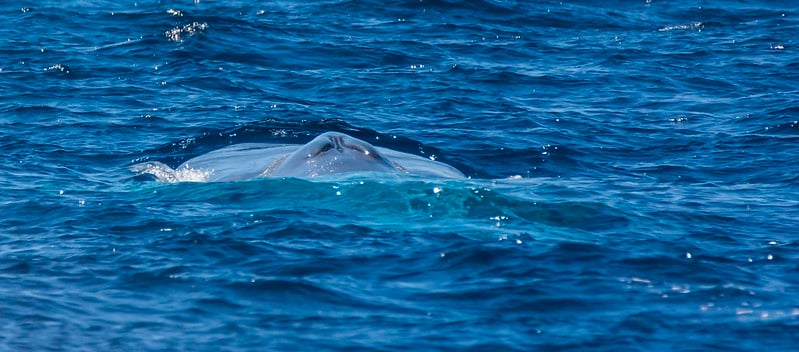
In a remarkable comeback, the majestic blue whales, Earth’s biggest creatures, have returned to a stretch of the Indian Ocean where they had vanished due to whaling many years ago.
In 2020 and 2021, scientists and filmmakers in the Seychelles documented the presence of these magnificent creatures. This extraordinary footage is now showcased in the immersive Imax film titled Blue Whales 3D.
However, what’s even more intriguing is a year-long effort of recording underwater sounds. This audio exploration unveiled a surprising revelation—the blue whales are spending extended periods in this area.
Experts suggest that this extended stay could indicate a potential breeding ground, marking a crucial development in the conservation of these awe-inspiring giants.
Victory for Conservation
A team of researchers, including scientists from the University of Seychelles, celebrated a significant victory for conservation. They dubbed the finding a “win” after the population of blue whales was severely reduced by the Soviet whaling fleet in the 1960s.
One of the main investigators, Dr. Kate Stafford, revealed, “It turns out if you stop killing animals on mass scales and you give them a chance to rebound, they can recover.” This highlights the positive impact that conservation efforts can have on the recovery of animal populations.
Commercial whaling
The effects of commercial whaling have had a lasting impact. Only a small fraction of blue whales remains, and the species has been classified as endangered by the International Union for the Conservation of Nature.
In the southern hemisphere, over three hundred thousand blue whales were hunted down by advanced and swift whaling vessels. This historical context underscores the immense impact of human activities on these majestic creatures and emphasizes the urgent need for conservation efforts to protect and restore their populations.
Stafford, expressing the significance of the discovery, highlighted that “this is the largest animal to ever exist on the planet. We want to know where they are coming back and knowing there’s a population around the Seychelles is incredibly exciting.”
Sound trap to record the presence of whales
The findings, published in the Journal of Endangered Species Research, resulted from deploying a “sound trap” fixed to the seabed near the small island nation. This contraption, equipped with underwater microphones, batteries, and recording devices, diligently recorded fifteen minutes of every hour every day for an entire year.
During the team’s month-long expedition, Stafford also dedicated a few hours each day to submerging a hydrophone (underwater microphone) into the water, adding a hands-on element to the research process.
Chris Watson, the wildlife sound recordist on the expedition, shared, “We heard remarkable things—the tapping of sperm whales thousands of feet down and dolphins echolocating and communicating but sadly no blue whales.”
Surprisingly, when scientists recovered their sound trap and meticulously examined the recordings, they discovered that blue whales were indeed present and communicating during times when the researchers were unaware.
Blue whales: Ocean giants return to ‘safe’ tropical haven
Blue whales – the largest animals on Earth – are making their home in a part of the Indian Ocean where they were wiped out by whaling decades ago.
Researchers and filmmakers in the Seychelles captured footage… pic.twitter.com/Fejgw40GOJ
— Manh Truong (@RumTruong) November 23, 2023
The distinct, very low-frequency songs of the mammals were notably audible, particularly in the months of March and April. This shed light on the communication patterns of these majestic creatures in the region.
Stafford emphasized the potential significance of the Seychelles for blue whales, stating that “this means the Seychelles could be really important for blue whales.”
She explained that “they sing during the breeding season and we think it’s probably the males who are singing, based on what we know about other whales.”
“So there’s also potential that the Seychelles is a breeding area or a nursery area,” she added.
Acoustic population of the blue whales
Remarkably, the scientists were able to identify which acoustic population the blue whales in the region belonged to.
Stafford explained, “You can tell them apart by the sounds they make. In the Seychelles, we heard one acoustic population—the one generally associated with the northern Indian Ocean.”
The song of the blue whale operates at a fundamental frequency so deep that it surpasses the range of human hearing. However, Watson, who successfully recorded blue whales in the Sea of Cortez, explained that we can hear what are known as harmonics—higher frequency sounds that “ring out” when a blue whale sings.
Seychelles’ significance for the conservation of blue whales
In the pursuit of safeguarding blue whales, conservation scientists are eager to unravel the Seychelles’ significance for these majestic creatures. A specific region around the islands has gained formal protection through a distinctive “debt for nature” agreement.
In this arrangement, the country saw nearly £16.8 million ($22 million) of its national debt forgiven in exchange for an increased commitment to ocean protection. As a result, approximately four hundred thousand square kilometers (154,000 square miles) of its seas now enjoy protection.
A primary concern is shielding crucial areas for blue whales from noise pollution, which efficiently travels through water. Stafford noted, “There’s not a tremendous amount of ship traffic in the Seychelles so perhaps we could think of it as a nice, quiet, safe place for blue whales.”
This emphasizes the importance of minimizing potential disruptions in this peaceful haven for the well-being of blue whales and other marine life.